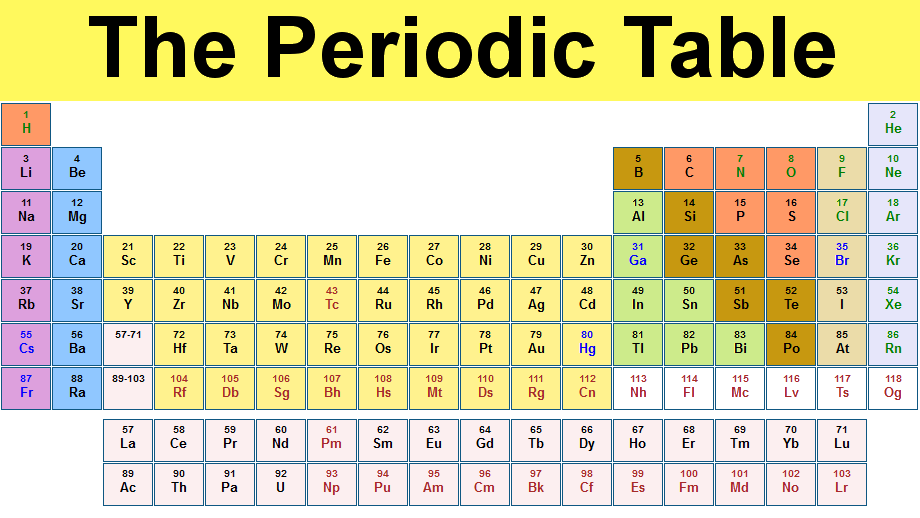Key Points in Chemistry
Quotes for Students

Too often we underestimate the power of a touch, a smile, a kind word, a listening ear, an honest compliment, or the smallest act of caring, all of which have the potential to turn a life around - Leo Buscaglia
The most important things we can give to others are actually not expensive. In fact, we don't have to buy them with money because they are right within us.
These include our kind words, listening ears, honest compliments, our 'thank you', those beautiful smiles, our loving corrections, sincere kindness and a caring heart
In the end, it isn't the years in your life that count. It is the life in your years - Abraham Lincoln
One fact remains constant to us all, and that's death. We are not guaranteed of tomorrow because no living human is too old to die, even a newly born. Remember, age is also a number.
Therefore, let us always do good, help the poor, care for the sick and less privileged, forgive transgressions and most importantly, extend the hands of love to everyone we come across.
By doing this, we would have added an abundance of life to our years, regardless its number. Recall that Jesus Christ Himself died at 33

You cannot win everytime. This therefore makes defeat a part of life. However, it is the way and manner at which we rise from our defeats that determines our place among the greats.
Muhammad Ali was a professional boxer with 56 wins and 5 defeats. However, the way and manner at which he rose from his defeats secured his place in boxing history as the greatest fighter of all time
One Day or Day One, you decide - Unknown
We all intend to become great in life. However, we should also understand that it doesn't take one day to become great. Rather it takes many days of work, practice, diligence, failures and successes to become great.
My question to you is this: Concerning your path to greatness, what day are you in?
Whatever you are, be a good one - Abraham Lincoln
If you are a boy, be a good boy. If you are a girl, be a good girl. If you are a man, be a good man. If you are a woman, be a good woman. If you are a student, be a good student. If you are a teacher, be a good teacher.
I can go on and on; but the point is: You are human, so do all in your power to be a good human
Below are the physical properties of metals:
They exist in solid state.
The have high densities.
They are good conductors of heat and electricity.
The have the ability to be polished, to glow, sparkle and reflect light.
They can be bent, flattened and made into sheets called foils.
They can be drawn into wires.
Iron undergoes magnetism while most metals are poorly magnetized.
They typical have high melting point.
They generally have high boiling point.
With the exception of lithium, sodium and potassium, most metals are generally hard.
They have the ability to make sound when in contact with other objects or metals.
Please read details on the physical properties of metals here
John Dalton is an English chemist who brought clarity into the composition of matter and the basis for their chemical reactions.
Below are Dalton's Atomic Theory:
All matter consists of tiny indivisible particles called atoms.
Atoms of the same element are identical to each other in every aspect because they have the same shape and mass, while atoms of different elements are different in all respect.
Atoms are indestructible and can neither be created nor destroyed.
Atoms of different elements can combine with each other in simple whole number ratios to form compounds.
Atoms of the same element share similar physical and chemical properties. They can also combine in more than one ratio to form two or more compounds.
Meanwhile, understand that the above theories of John Dalton had been modified.
Please read on Dalton's atomic theory and its modifications here

The periodic table, also called periodic table of elements or Mendeleev's table, is a table that shows an organized arrangement of the 118 chemical elements according to their atomic number.
Out of the 118 elements; elements 1 - 94 are present in nature while elements 95 - 118 are synthesized artificially.
The manner at which elements are arranged on this table reveals some similarities in their electronic configurations and chemical properties.
A compound composed of iron (Fe) and oxygen (O) was analyzed and found to contain 69.94% iron and 30.06% oxygen. Find the empirical formula of the compound. (Molar mass of Fe=55.85, O=16)
Step 1: Identify the given parameter from the question.
Fe = 69.94%, O = 30.06%.
Empirical formula = Fe?O?
Step 2: Convert the percentages to gram. (just attribute grams to the %).
Step 3: To get the mole ratio of each element, convert the gram to moles using the formula (mole = mass/molarmass). Please merorize this formula because we always work with moles in emperical formula.
Mole of Fe: 69.94/55.85 = 1.252mol
Mole of O: 30.06/16 = 1.879mol
Step 4: Divide both sides by the smallest mole ratio.
Iron has the smallest mole ratio in our case, therefore: 1.252/1.252 = 1, 1.879/1.252 = 1.5
We now have the formula = Fe1O1.5
Step 5: Multiply each of the moles by the smallest whole number that will convert each into a whole number. (In our case, the number '2' is the smallest whole number that will make '1.5' and '1' whole numbers when multiplied by it.
For iron (Fe), we will have 1 x 2 = 2
For oxygen (O), we will have 1.5 x 2 = 3
Step 6: Write the empirical formula.
The empirical formula= Fe2O3
Iron(III)tetraoxosulphate(VI)
In chemistry, hydrocarbons can be classified as either aliphatic or aromatic. Recently, both classifications of hydrocarbon were based on their structure rather than their origin.
Aliphatic hydrocarbons are put into three main groups according to the types of bonds they possess. These are:
Alkanes
Alkenes
Alkynes
They are shown in the image below:

It's important to note the followings:
Alkanes have single bonds (only) in their structures.
Alkenes always have a carbon-carbon double bond present in their structure.
Alkynes always have a carbon-carbon triple bond present in their structure.
Aromatic hydrocarbons are classified into:

Organic chemistry is the study of carbon and it's compounds.
Carbon is the focus of organic chemistry because it has a wide chemical diversity in the sense that it can combine with other carbon atoms to form a long chain of carbon molecule. This ability and process whereby carbon can form a long chain of itself is called catenation.
A major challenge encountered when calculating molecular mass is that it becomes difficult or impossible to calculate especially when the relative molecular mass of large molecules, polymers and macromolecules are involved.
Examples of large molecules (with indefinite molecular masses) include carbohydrates, cellulose and complex sugars.
The large molecules (above) have no specific chemical formula throughout their volume.
Understand that Relative Molecular Mass prove to be useful only when we calculate substances with small and definite molecular sizes. This was proven through the modifications of Dalton's atomic theory.
Please read on Dalton's atomic theory and its modifications here.
Calculate the Relative Molecular Mass of methane (CH4). (Carbon=12.001 and H=1.00794)
Molecular Mass = Atomic mass of carbon + Atomic mass of Hydrogen
Methane is composed of one atom of Carbon and 4 atoms of Hydrogen.
12.001 + (1.00794 x 4)
Molecular Mass of Methane = 16.033 amu
Calculate the Relative Molecular Mass of water (H2O). (Oxygen=15.9994 and Hydrogen=1.00794)
Molecular Mass = Atomic mass of Hydrogen + Atomic mass of Oxygen
Water contains 2 atoms of Hydrogen and 1 atom of oxygen.
(1.00794 x 2) + 15.9994
Molecular Mass of Water = 18.015 Da

Below are some facts about gold:
It is the only metal that has a gold (golden) color
Gold is present inside the earth crust in all the seven continents
Pure gold is soft and very stretchable (It can even be stretched into threads)
The Latin name of Gold is aurum which means 'shining dawn'. For this reason, its chemical symbol is 'Au'
Gold is a very good conductor of electricity. This is why it’s sometimes used in making USB and audio cables
Gold is non toxic and can be eaten with food. It is sometimes added to desserts in some expensive restaurants
The term Gold originated from an ancient English word 'geolu' which means yellow
24karat gold is the purest gold element
An acid has a variety of definitions.
An acid is a substance that produces hydrogen ions (H+) when dissolved in water (or when in the form of an aqueous solution).
Svante Arrhenius definition of Acid
An acid is a substance that donates a proton in a chemical reaction.
Brønsted Thomas Martin Lowry definition of Acid
An acid is a substance that accept an electron pair in a chemical reaction.
Gilbert Newton Lewis definition of Acid
Finally, acids can also be also defined as substances that gives out hydronium ion (H3O+) when dissolved in water.
In summary, all acids will always contain the positive H+ (cation) and an anionic group in their formula. For instance, the acid HCl (Hydrogen Chloride) contains H+ as cation and Cl- as its anion.
Please read the explanations of the above definitions of acid here
Total Topics (10) Paged
Page (1 of 1)
Academic Questions in Chemistry
With regards to redox reactions, which of the following statement is wrong?
A. Redox reaction are examples of chemical change
B. Reduction is the gain of electron
C. Substances that donates election during chemical reaction are termed reductants
D. Oxidizing agents are always reduced in chemical reactions
E. Oxidation occurs at the cathode in electrolysis
F. Hydrogen is a reducing agent
Chemistry
In chemistry, physical change is associated only with the rearrangement of molecules while the internal composition of the substance remains the same.
A. True
B. False
Chemistry
_____ electron(s) is a term that describes the number of electron(s) in the outermost shell of an atom.
A. Outer
B. Excess
C. Valence
D. Positive
E. Negative
F. Last
Chemistry
_____ is the negative electrode in electrolysis.
A. Anode
B. Anion
C. Cathode
D. Cation
E. Ion
F. Electrolyte
Chemistry

The above diagram shows the _____ type of bond.
A. Covalent
B. Polar covalent
C. Coordinate covalent
D. Metallic
E. Van dear walls
F. Ionic
Chemistry
Metals are referred to as _____ in their impure state.
A. Diluted
B. Consecrated
C. Coloured
D. Ores
E. Stained
F. Strained
Chemistry
Metals generally have the quality to shine, glow, sparkle, glitter, reflect light and be polished. This characteristic of metals is termed _____.
A. State
B. Ductility
C. Luster
D. Malleability
E. Hardness
F. Inflorescence
Chemistry